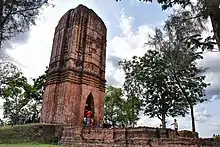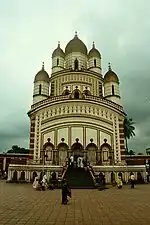Jatar Deul
Jatar Deul is located in district South 24 Parganas of the Indian state West Bengal.[1][2] This is a brick temple and is datable to c. 10th -11th century AD on the basis of its architecture.[1] However, this type of brick temple we can see at Nebia Khera, Uttar Pradesh.[3]
| Jatar Deul | |
|---|---|
 | |
| Religion | |
| Affiliation | Hinduism |
| Deity | Shiva |
| Location | |
| Location | Kankan Dighi/Jata South 24 Parganas |
| State | West Bengal |
| Country | India |
 Location in West Bengal  Location in India | |
| Geographic coordinates | 21°59′33″N 88°29′15″E |
| Architecture | |
| Completed | 11th century |
| Elevation | 30 m (98 ft) |
Geography
M: municipal city/ town, CT: census town, R: rural/ urban centre, N: neighbourhood, T: religious centre
Owing to space constraints in the small map, the actual locations in a larger map may vary slightly
Location
The Jatar-Deul stands isolated on a small hill in the surroundings of the locality Kanakan Dighi, about 5 km east of the small town of Raidighi in the Mathurapur II community development block in the Diamond Harbour subdivision of the district of South 24 Parganas in West Bengal.[4]
Note: The map alongside presents some of the notable locations in the subdivision. All places marked in the map are linked in the larger full screen map.
History

The temple is known by the name of "Jatar Deul ".[5] This brick temple is traditionally connected with an inscription (not traceable now) of one Raja Jayantachandra, purported to have been issued in 975 AD.[1] It was probably dedicated to Mahadev or Siva, who also goes by the name of Jatadhari.[5] The Archaeological Department board at the temple site places establishment around 11th century.[4] However there was no deity inside the temple.[1] The discovery of Jatar Deul dates back to the middle of the nineteenth century, when land surveyors stumbled upon a towering brick structure in the midst of the Sundarban.[4]
Consecration
What purpose it served is now a matter of conjecture.[6]There is neither a cult nor any other sculptural or inscriptional evidence available, it is also the consecration of the temple is unclear – some believe it was originally for a Buddhist structure; others see it as a building in honor of the Hindu God Shiva (Mahadev).[7]
Architecture
It towers nearly 100 ft. above the plain.[8] The entrance which is on the east is 9.5 ft. wide and is spanned by a pointed arch.[8] The inside is about 10 ft. square and the walls are about 10 ft. thick.[8] No plinth is visible and the floor is some six feet below the ground, and is reached by a flight of steps.[8]
According to the List of Monuments of National Importance in West Bengal Jatar Deul is an ASI listed monument.[2]
References
- "ASI, Kolkata Circle".
- "List of Ancient Monuments and Archaeological Sites and Remains of West Bengal - Archaeological Survey of India". Item no. 6. ASI. Retrieved 25 January 2020.
- http://m.timesofindia.com/city/lucknow/on-a-trail-to-explore-stories-behind-brick-temples/articleshow/63154081.cms.
{{cite web}}: Missing or empty|title=(help) - Datta, Rangan. "Jatar Deul horse race: Inexperienced riders, uneven tracks and unbridled fun". Retrieved 21 April 2022.
- "List of Ancient Monuments in Bengal".
- "Monographs of the Varendra Research Society no. 3 by Majumdar N.G."
- Ghosh, Binoy, Paschim Banger Sanskriti, (in Bengali), part III, 1980 edition, pages 152-155, Prakash Bhaban, Kolkata
- "Monographs of the Varendra Research Society no. 3, by Majumdar N.G."
